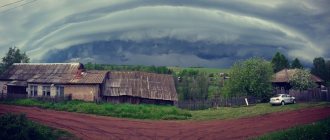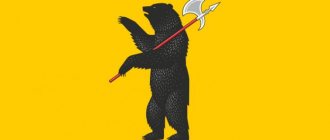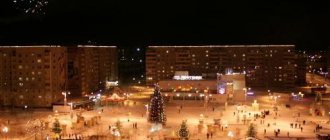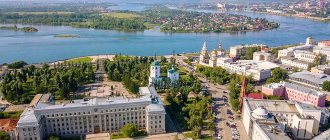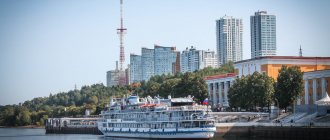The city of Tarusa in the Kaluga region fits on only 12 square kilometers. The population here does not even reach 10 thousand people.
The city gained fame thanks to poets, writers and artists who worked here at different times. Konstantin Paustovsky spent most of his life here, Marina Tsvetaeva came to the city for the summer in her childhood and youth. Poet Bella Akhmadulina was unable to buy an apartment in Tarusa; she rented housing here with her husband from 1974 until the collapse of the Union. The artist Vasily Polenov had a dacha in the city, where he spent a lot of time.
Creative personalities loved Tarusa for its privacy and patriarchy, which has survived into the 21st century. A significant part of the town’s attractions are associated with those who lived and worked here.
From Tarusa you can go to Serpukhov, 40 kilometers away (where there are not only temples and museums, but also real peacocks, ostriches and bison), or you can go to Kaluga, 80 kilometers away, for, for example, the Tsiolkovsky Museum.
Lenin Street and Square
The communist regime ended long ago, but the main street of the city retained the same name. The center of Tarusa is built up with cute one-story houses of the 19th-20th centuries.
The station building is located on Lenin Street, 2. Because of fears that the city would turn into an industrial one, the railway to Tarusa was never built. But the typical station of the early 20th century remains.
On Lenin Square, opposite the Peter and Paul Cathedral, there is a monument to Lieutenant General M.G. Efremov, a native of Tarusa.
Igumnov ravine
The Tsvetaevs called the wonderful view opening onto the ravine “Tyrol” or “Tarussa Switzerland”.
For a long time, the water of the spring gushing from an ancient adit has been recognized as holy, healing, and has an extraordinary taste. However, for a long time it was used by the Tarusans to satisfy their economic needs. Not far from the source, a “rinse” was equipped - a small pool intended for rinsing clothes, into which water flows after passing through the chapel, the holy well and the font.
Near the source there are a newly built chapel in honor of the Bogolyubskaya Icon of the Mother of God and a bathhouse.
The house of writers A.K. Vinogradov and N.V. Bogdanov is located above the ravine next to the Tarusa regional children's library named after N.V. Bogdanov (white brick building). This house is made of logs, gray-blue in color, with a mezzanine. You can recognize it by the green fence adjacent to the library. A. K. Vinogradov (1888–1946) and N. V. Bogdanov (1906–1989) lived and worked here at different times. The house is marked with two memorial plaques. Marina and Anastasia Tsvetaeva, V.D. Polenov, V.A. Vatagin, K.G. Paustovsky visited it. The building was erected in 1890 by the father of Anatoly Kornelievich Vinogradov. A.K. Vinogradov was a writer, scientist, literary critic, expert diplomat, translator of Polish and French literature, organizer of Soviet librarianship, and aviator. He wrote the novels “The Black Consul”, “The Three Colors of Time”, “The Condemnation of Paganini”, “Byron”, “Stendhal and His Time”, which became popular in the mid-1980s. Anatoly Kornelievich made sketches of the first books and many notes in Tarusa. His connection with the city continued until 1941.
In 1958, this house was purchased from the sister of A.K. Vinogradov by the writer, journalist, and front-line correspondent N.V. Bogdanov. I would like to note that the writer began coming to Tarusa for rest and work in 1948. N.V. Bogdanov is well known as the author of the books “About the Brave and Skillful”, “The First Girl”, “Pioneer Stories”, “Evenings at Ukomov’s Tables”. In 1966, the writer’s two-volume book was published. He donated the fee for the collection to the construction of a children's library in Tarusa, which today bears his name. Its facade has recently been updated and decorated with a sculptural composition made of metal by A. Volkov, a member of the Union of Artists of Russia.
Cathedral of Peter and Paul
Address: Lenin Square Phone: +7 (48435) 2-51-88 Website: https://tarusa.cerkov.ru/ Opening hours: 09.00-16.00 Mon-Sun
The construction of the temple in 1789 was personally financed by Catherine II. It is believed that the architect of the building was Ivan Denisovich Yasnygin.
The stone cathedral was rebuilt several times, wanting to bring it to perfection. The temple was closed under the communists and reopened in 1998. The interior decoration took 10 years to restore, from 1999 to 2009. The arrangement of the temple premises during reconstruction was brought as close as possible to the 18th-century setting.
Tarusa Art Gallery
Address: st. Lenina, 1-a Phone: +7 (48435) 2-51-83 Opening hours: 10.00-17.00 Wed-Sun, Mon, Tue - weekends Cost: 90 rubles
The gallery was opened in 1963. This had to be done: collector N.P. Rakitsky donated more than 200 exhibits to the city at once. Most of the works of art in the museum are associated with masters who once lived in Tarusa.
Some of the exhibits came from the Tretyakov Gallery: works by Aivazovsky and Lagorio. The Tarusa gallery presents paintings by European painters and examples of contemporary art.
Embankment
The shores of the Oka River are loved by both locals and tourists. Vacationers are attracted primarily by the pier, hotels and restaurants. But there are also 3 interesting monuments on the city embankment:
- Stone in memory of Marina Tsvetaeva, made by Semyon Ostrovsky in 1962. Due to the turbulent political situation in the country, the author had to hide the work. The stove was installed in 1988 in the place where the poetess often walked.
- The monument to Bella Akhmadulina was created by her husband Boris Messerer. The townspeople take special care of the object: the poetess never had her own home in Tarusa, which is why there is no museum named after her. Only the monument reminds us that Akhmadulina lived in the city for quite a long time.
- The monument to Konstantin Georgievich Paustovsky was opened on the 120th anniversary of the writer. The prose writer lived in Tarusa for 20 years. Paustovsky described the surroundings of the city in his works and admitted that the main source of his inspiration was Oka.
What to bring
Tarusa, whose attractions are far from the only calling card of the Kaluga region, is rich in a variety of souvenirs:
- Tourists who come here are sure to buy products from local craftsmen made of ceramics and wood, as well as paintings.
- Many people prefer to purchase linen products (bed linen and clothing) in Tarusa.
- In the arts and crafts store “Ksyusha”, located at pl. Lenina, 5, a large selection of souvenirs with the symbols of the city for different tastes and budgets.
- When leaving the city, there is sometimes a small market where locals sell domestic and wild berries, as well as fresh mushrooms.
Tarusa is a small and hospitable city. All its attractions can be visited in 1-2 days. At the same time, you should definitely pay attention to the nature of this place.
Many famous creative people said and wrote that “Tarusa is a city where inspiration comes!”
Author of the article: Ksenia Schneider
Article design: Svetlana Ovsyanikova
Church of the Resurrection
Address: st. Efremova, 7 Phone: +7 (48435) 2-51-88 Opening hours: 08.00-16.00 Sat, Sun, Mon-Fri - days off
The temple is the oldest building in the city. The church was rebuilt and improved many times. When the Communists came to power, the temple was closed and reopened in 1988. The church was restored quickly, thanks to donations from townspeople. Even famous artists invested financially in the reconstruction: Batalov, Dobryan, Zuev.
The building is located in a secluded picturesque place on the mountain. The temple is separated from the city by a deep ravine.
House-museum of the Tsvetaev family
Address: st. Roses Luxemburg, 30 Phone: +7 (48435) 2-51-92 Opening hours: 10.00-17.00 Tue-Sat, Mon - closed Cost: 70 rubles
The house was bought by the poetess’s grandfather; Tsvetaeva spent her childhood and youth here. The museum's exhibits include personal belongings of the family and their friends. The furniture in the museum came from the family’s Moscow apartment.
Despite the small size of the building, employees organized 5 exhibitions:
- dedicated to the city of the 19th century;
- associated with friends of the poetess;
- illuminating the work of Tsvetaeva;
- cabinet;
- living room
In the museum you can buy souvenirs dedicated to the famous family.
House-Museum of K.G. Paustovsky
Address: st. Proletarskaya, 2 Phone: +7 (48435) 2-50-70 Website: https://mirpaustowskogo.ru/ Opening hours: 11.00-18.00 Fri-Sun, Mon-Thu - days off Cost: 200 rubles
Paustovsky lived in a small log house for 9 years. The museum was opened to visitors in 2012.
The interior of the building has a mid-20th century feel. The writer’s office contains his personal belongings: a typewriter, books, furniture.
The table is decorated with a photograph of Marlene Dietrich, which was given to Paustovsky by the actress herself, a fan of the writer’s works.
The museum staff organizes 3 types of excursions:
- to Paustovsky’s memorial places;
- through the old estates where the writer lived or often visited;
- a river walk to Richter's dacha, where Konstantin Georgievich loved to be.
How to get there
There are several ways to get to Tarusa.
From Moscow:
| Transport | Travel time | Ticket | Peculiarities |
| Bus | 2.5 hours | 325 rub. | No. 539. Departs daily from the station. Teply Stan metro station at 09:10, 12:55, 20:10. |
| Personal car | 2 hours 05 minutes | — | You need to leave Moscow along the Simferopol highway. Drive 75 km to Serpukhov. Then head about 7 km along the road towards the city of Protvino. Then, at the historical monument “Tank”, turn at the fork in the road following the sign “Tarusa”. |
| Electric train | 1 hour 40 minutes – 2 hours | From 275 rub. | Departs daily from the Tsaritsyno metro station, Kalanchevskaya metro station, Tekstilshchiki metro station and from the Kursky station to the Serpukhov railway station. Next you need to transfer to bus No. 131 to Tarusa. Important information! Tickets to the station are on sale. “Tarusskaya”, which has no relation to the city of Tarusa (it is located in the Tula region). |
| Taxi | 1 hour 50 minutes | From 2000 rub. | It is better to find out the cost of the trip in advance from the operator who accepts the order. |
From Serpukhov:
| Transport | Travel time | Ticket | Peculiarities |
| Bus | 45 min. | 100 rub. | No. 245. It departs from the city bus station every 30-40 minutes every day. |
| Minibus | 40 min. | 140 rub. | No. 245. Departs from the city bus station on Fridays. The movement interval is 1.5-2 hours. |
| Personal car | 35 min. | — | It is not recommended to leave the highway in search of a shortcut. |
| Taxi | 30 min. | From 500 rub. | It is better to find out the cost of the trip in advance from the operator who places the order. |
From Kaluga:
| Transport | Travel time | Ticket | Peculiarities |
| Bus | 1.5 hours | From 200 rub. | Departs from the station. Kaluga-1 on weekdays according to the schedule - 9:30, 11:00, 14:50, 15:30, 18:30. On weekends - 9:30, 11:00, 15:30, 18:30. |
| Personal car | 1 hour 10 minutes | — | Along the way there will be at least 18 gas stations and 3 tire shops. |
| Taxi | 50 min. | From 700 rub. | It is better to find out the cost of the trip in advance from the operator who accepts the order. |
Private museum
Address: st. Shmidta, 11a Phone: 8-910-600-17-36 Website: https://www.tarusamuseum.ru/ Opening hours: by agreement Cost: 150 rubles
The first private museum in Tarusa was opened by an ordinary citizen Sergei Zharov in his own home. A large room has been allocated for the exhibition hall. The most extensive collection of irons is presented: gas, alcohol, especially for trousers; made in England, Germany, Holland.
Other interesting exhibits of the museum:
- kerosene lamps;
- gramophones;
- photographs of the city over the years;
- vintage sewing machines.
In the courtyard of the house there are sculptures created by the owner. Zharov made metal Onegin, Clinton, Chubais, and there are also figures of heroes from children's fairy tales on the territory.
Everything in the museum is allowed to be touched and photographed.
In 2022, master Sergei Zharov died. His wife continues to conduct excursions.
Dacha "Sand"
At the end of the 19th century, the Tarusa Zemstvo built a dacha on the banks of the Oka River for rent to Muscovites. From 1892 to 1910, this house “two miles from the city” was rented by Ivan Vladimirovich Tsvetaev, a professor at Moscow University, founder and collector of the Museum of Fine Arts (now the Pushkin Museum), an outstanding philologist, the father of Marina Tsvetaeva. This is how Anastasia Ivanovna Tsvetaeva (sister of Marina Ivanovna Tsvetaeva, writer, memoirist) describes the house in her book “Memoirs”: “A simple gray plank house under a rusty iron roof. The ladder from the lower balcony goes straight into the lilac tree. Swing pillars; the old bench under the huge willow is barely visible - it’s so dense all around. In a high fence there is a gate to the road. If you stand facing the Oka, to the left there are beds, behind them are raspberries, currants and gooseberries, behind the house there is a croquet court... I don’t know and can’t imagine a more complete, happier childhood than ours in Tarusa.” The linden alley planted by Ivan Tsvetaev and two of the three spruce trees he planted in honor of his daughters have been preserved. In 1941, shortly after Marina Tsvetaeva’s suicide in distant Yelabuga, her spruce tree in Tarusa began to dry out and fall off. This mystical story formed the basis of Anastasia Tsvetaeva’s story “Yolka”. In 2010, a bust was erected at the entrance to the holiday home of I. V. Tsvetaeva.
Poems about Tarusa were included in M. Tsvetaeva’s first book, “Evening Album,” and in “The Magic Lantern” they make up the “Oka” cycle.
From March to October 1905, V.E. lived and worked at the Pesochnoe dacha. Borisov-Musatov. During this time, he painted his best paintings: “Autumn Song”, “Hazel Bush”, “Wreaths of Cornflowers”, “Requiem”. Painting “On the balcony. Tarusa" - view from the terrace of the Tsvetaevs’ house on the Oka River.
The Wulf family settled in the city dacha “Pesochnoe” in 1914. Georgy Viktorovich Wulf (1863–1925) is an outstanding Russian crystallographer. The scientist’s laboratory was located in the Pesochny annex, nicknamed the “Hermitage” for its privacy. His wife Vera Vasilievna Wulf (1871–1923) is a pianist, artist, sister of the wife of the artist V. D. Polenov.
The Wulfs took an active part in the cultural life of the city. Through their efforts, the People's House was created in Tarusa, concerts and artist exhibitions were constantly organized. At the Pesochnoye dacha, Vera Vasilyevna Wulf opened the Borisov-Musatov Museum and maintained it during her lifetime. “Vera Vasilievna brought with her the light and warmth of art to Tarusa... All year round, in any weather... strings of Tarusans flocked to Vera Vasilievna’s house on Saturday evenings to listen to Bach, Beethoven, Scriabin, Medtner, and up to 70 people crammed into the small house.” . Only for 1921-1922. she gave up to 100 free concerts. The Wulf family has repeatedly made attempts to preserve the Pesochnoye dacha as a museum for the Tsvetaevs and Borisov-Musatov. However, they did not succeed.
In 1932, the house was acquired by the board of the State Bank and a summer health resort was built - a holiday home named after V.V. Kuibyshev. The service staff lived at the dacha itself. In the 1960s it was moved to a new building. In 1937, two permanent buildings were built, as well as a residential building and a dining room. It was in 1937 that the health resort began to accept vacationers all year round. In 1946, the health resort came under the jurisdiction of the Central Committee of the Trade Union of Financial Workers. In 1952, another dormitory building was built, a club-dining room with a spacious and bright dining room and a hall “for carrying out cultural work.” (Nowadays the “House of Writers” of Tarusa). In the mid-1960s, the Pesochnoe dacha was destroyed. Where it was located, a dance floor was built for vacationers at the rest home named after V.V. Kuibyshev. Sculptures of V.I. were installed in the park. Lenin, M. Gorky, N.V. Gogol.
Currently, the holiday home has been restored, partially rebuilt and renamed “Silver Age”.
A model of the Pesochnoe dacha can be seen in the Tsvetaev family museum in Tarusa.
Valley of Dreams
Address: Tarusa, Pochuevskaya Valley How to get there: on foot or by car, 10 km north of the city
The ravine, which received its poetic name from Marina Tsvetaeva, has inspired artists at all times. The place is calm, the atmosphere here is peaceful. Flowers and berries grow along the slopes of the ravine. Despite the rosy picture, ufologists rendered their verdict - the area is anomalous. The possibility of a personal meeting with an alien, of course, did not deter tourists.
The ravine stretches for 4 km and resembles a canyon. A stream flows in the valley of the ravine. Local residents say that soap was actively brewed here for a long time. Even so, the water in the stream remained clean and clear.
Asleep boy
Here lies the most talented artist of Russia, Viktor Elpidiforovich Borisov-Musatov (1870–1905). At this place there used to be a Khlystov cemetery, which has not survived.
V. E. Borisov-Musatov was invited to Tarusa by I. V. Tsvetaev (father of M. I. Tsvetaeva). He lived at the dacha in “Pesochny” in anticipation of a big order and painted a lot in his own style - “with delicate, melting colors.” The painting “Autumn Song” is a view of the Oka River from the slope where we are. Two birch trees with yellowed leaves bent over the Oka River. In the distance are meadows and forests. A long school of cranes floats across the gray sky. It seems that you can hear their plaintive purring.
The artist really liked this slope, as his relatives knew well.
When V. E. Borisov-Musatov suddenly died on October 26, 1905 after a cold contracted on a boat trip, he was buried in his favorite place. A few years later, a granite tombstone “Asleep Boy” was installed on the artist’s grave, made by his friend, sculptor A. Matveev. In the boy carved from granite, the author symbolically depicted Borisov-Musatov, a young genius who left the world prematurely. Among the Tarusans there lives a poetic legend about self-sacrifice. As if the artist, walking along the Oka, saw a child drowning in the river. Despite his illness, he rushed into the water, saved a drowning man, but became mortally ill himself.
Right there, on the Musatov slope, the artist’s sister and the Wulf family sleep in eternal sleep.
Istomino Estate
Address: n/a Istomino How to get there: by car, 5 km from Tarusa to the east until the left turn to Istomino
The manor, built around 1720, has had many owners. The house survived war, revolution and changes in political regimes. The architecture of the building is a mixture of classicism and baroque layout. The reason for the unexpected style is numerous modifications to suit the taste of each owner.
By the 21st century, the estate was almost destroyed. Only the park has been completely preserved, partially the grotto, the house and the Assumption Church. It is believed that Leo Tolstoy periodically visited the estate. The pious count could not ignore the local church.
If you have not yet chosen where you will live and want to save money when booking, we recommend using the RoomGuru service. Firstly, it contains hotels, apartments and guest houses from many different booking systems, so you won’t miss out on a worthwhile option. Secondly, you can immediately compare prices for one place in different services and book where it is cheaper (this is not always Booking!).
Where to stay in Tarusa
The number of housing offers in Tarusa is small, but only here you can live near the house of K. Paustovsky (“Paustovsky’s Neighbors”) or in the area of the Tsvetaevs’ former dacha (“Silver Age”), partly understanding the charm of the places they chose. Booking one of the town's guest houses is an opportunity to live and walk along the quiet village streets of Tarusa like the outstanding minds of the past. The subtle, picturesque nature of the Oka is supported here by the concepts of the Velna Eco Resort hotel and the Beaver Cape ecopark, located in the vicinity of Tarusa. An option on the theme of history - and on the other side next to the estate of V. Polenov.
- Tarusa Hotels
- Hostels for Budget Travelers
- Flats and apartments
One way to intelligently save on a trip is to book accommodation on Booking.com with cashback Cashback promotion on Tourist. RU


